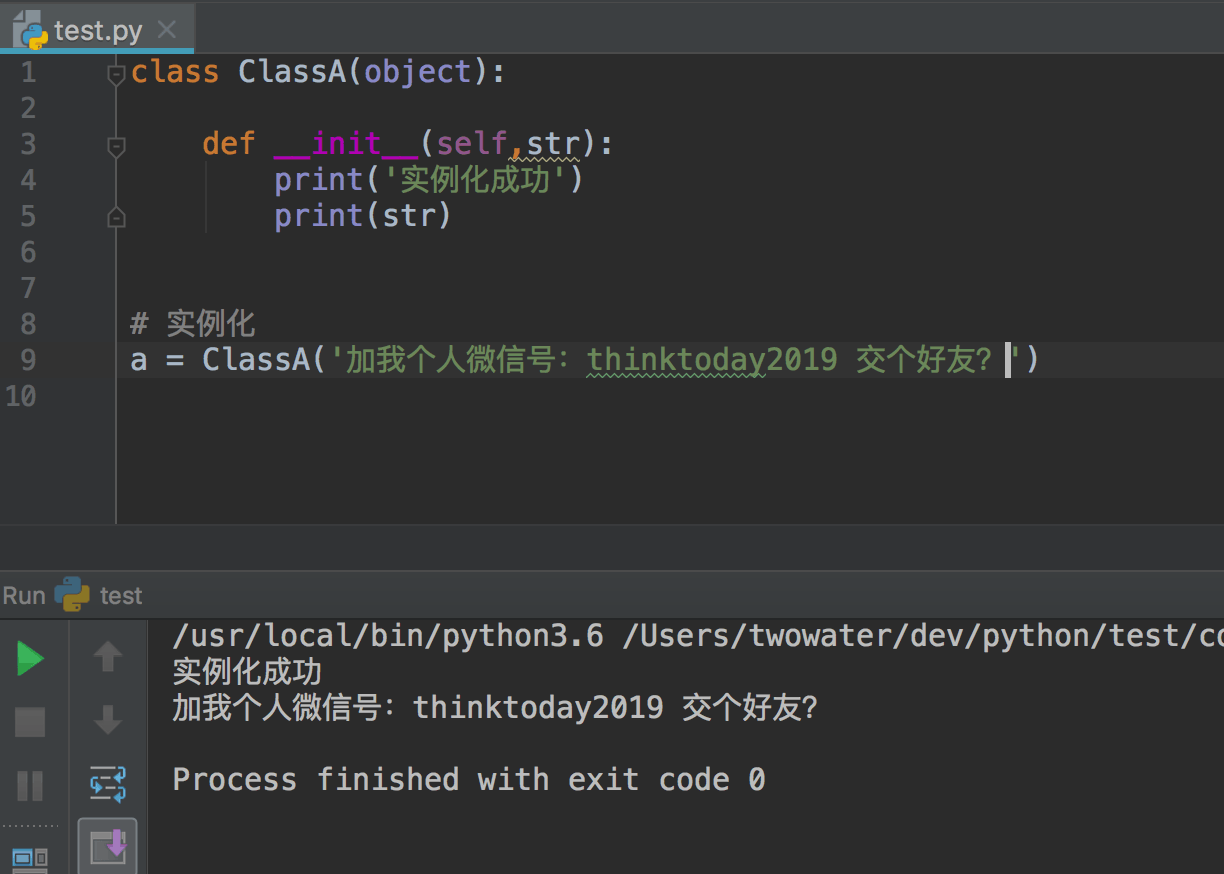147 lines
4.3 KiB
Markdown
147 lines
4.3 KiB
Markdown
# 六、初始化函数 #
|
||
|
||
|
||
|
||
## 1、什么是初始化函数 ##
|
||
|
||
初始化函数的意思是,当你创建一个实例的时候,这个函数就会被调用。
|
||
|
||
比如:
|
||
|
||

|
||
|
||
当代码在执行 `a = ClassA()` 的语句时,就自动调用了 `__init__(self)` 函数。
|
||
|
||
**而这个 `__init__(self)` 函数就是初始化函数,也叫构造函数。**
|
||
|
||
初始化函数的写法是固定的格式:中间是 `init`,意思是初始化,然后前后都要有【两个下划线】,然后 `__init__()` 的括号中,第一个参数一定要写上 `self`,不然会报错。
|
||
|
||
构造函数(初始化函数)格式如下:
|
||
|
||
```python
|
||
def __init__(self,[...):
|
||
```
|
||
|
||
|
||
初始化函数一样可以传递参数的,例如:
|
||
|
||

|
||
|
||
|
||
|
||
|
||
## 2、析构函数 ##
|
||
|
||
竟然一个在创建的时候,会调用构造函数,那么理所当然,这个当一个类销毁的时候,就会调用析构函数。
|
||
|
||
析构函数语法如下:
|
||
|
||
```python
|
||
def __del__(self,[...):
|
||
```
|
||
|
||
看下具体的示例:
|
||
|
||
|
||

|
||
|
||
|
||
|
||
## 3、Python 定义类的历史遗留问题 ##
|
||
|
||
Python 在版本的迭代中,有一个关于类的历史遗留问题,就是新式类和旧式类的问题,具体先看以下的代码:
|
||
|
||
```python
|
||
#!/usr/bin/env python
|
||
# -*- coding: UTF-8 -*-
|
||
|
||
# 旧式类
|
||
class OldClass:
|
||
pass
|
||
|
||
# 新式类
|
||
class NewClass(object):
|
||
pass
|
||
|
||
```
|
||
|
||
可以看到,这里使用了两者中不同的方式定义类,可以看到最大的不同就是,新式类继承了`object` 类,在 Python2 中,我们定义类的时候最好定义新式类,当然在 Python3 中不存在这个问题了,因为 Python3 中所有类都是新式类。
|
||
|
||
那么新式类和旧式类有什么区别呢?
|
||
|
||
运行下下面的那段代码:
|
||
|
||
```python
|
||
#!/usr/bin/env python
|
||
# -*- coding: UTF-8 -*-
|
||
|
||
# 旧式类
|
||
class OldClass:
|
||
def __init__(self, account, name):
|
||
self.account = account
|
||
self.name = name
|
||
|
||
|
||
# 新式类
|
||
class NewClass(object):
|
||
def __init__(self, account, name):
|
||
self.account = account
|
||
self.name = name
|
||
|
||
|
||
if __name__ == '__main__':
|
||
old_class = OldClass(111111, 'OldClass')
|
||
print(old_class)
|
||
print(type(old_class))
|
||
print(dir(old_class))
|
||
print('\n')
|
||
new_class = NewClass(222222, 'NewClass')
|
||
print(new_class)
|
||
print(type(new_class))
|
||
print(dir(new_class))
|
||
|
||
```
|
||
|
||
这是 python 2.7 运行的结果:
|
||
|
||
```
|
||
/Users/twowater/dev/python/test/venv/bin/python /Users/twowater/dev/python/test/com/twowater/test.py
|
||
<__main__.OldClass instance at 0x109a50560>
|
||
<type 'instance'>
|
||
['__doc__', '__init__', '__module__', 'account', 'name']
|
||
|
||
|
||
<__main__.NewClass object at 0x109a4b150>
|
||
<class '__main__.NewClass'>
|
||
['__class__', '__delattr__', '__dict__', '__doc__', '__format__', '__getattribute__', '__hash__', '__init__', '__module__', '__new__', '__reduce__', '__reduce_ex__', '__repr__', '__setattr__', '__sizeof__', '__str__', '__subclasshook__', '__weakref__', 'account', 'name']
|
||
|
||
Process finished with exit code 0
|
||
|
||
```
|
||
|
||
这是 Python 3.6 运行的结果:
|
||
|
||
```
|
||
/usr/local/bin/python3.6 /Users/twowater/dev/python/test/com/twowater/test.py
|
||
<__main__.OldClass object at 0x1038ba630>
|
||
<class '__main__.OldClass'>
|
||
['__class__', '__delattr__', '__dict__', '__dir__', '__doc__', '__eq__', '__format__', '__ge__', '__getattribute__', '__gt__', '__hash__', '__init__', '__init_subclass__', '__le__', '__lt__', '__module__', '__ne__', '__new__', '__reduce__', '__reduce_ex__', '__repr__', '__setattr__', '__sizeof__', '__str__', '__subclasshook__', '__weakref__', 'account', 'name']
|
||
|
||
|
||
<__main__.NewClass object at 0x103e3c9e8>
|
||
<class '__main__.NewClass'>
|
||
['__class__', '__delattr__', '__dict__', '__dir__', '__doc__', '__eq__', '__format__', '__ge__', '__getattribute__', '__gt__', '__hash__', '__init__', '__init_subclass__', '__le__', '__lt__', '__module__', '__ne__', '__new__', '__reduce__', '__reduce_ex__', '__repr__', '__setattr__', '__sizeof__', '__str__', '__subclasshook__', '__weakref__', 'account', 'name']
|
||
|
||
Process finished with exit code 0
|
||
|
||
```
|
||
|
||
|
||
仔细观察输出的结果,对比一下,就能观察出来,注意喔,Pyhton3 中输出的结果是一模一样的,因为Python3 中没有新式类旧式类的问题。
|
||
|
||
|
||
|
||
|
||
|
||
|